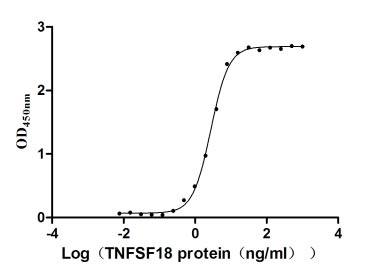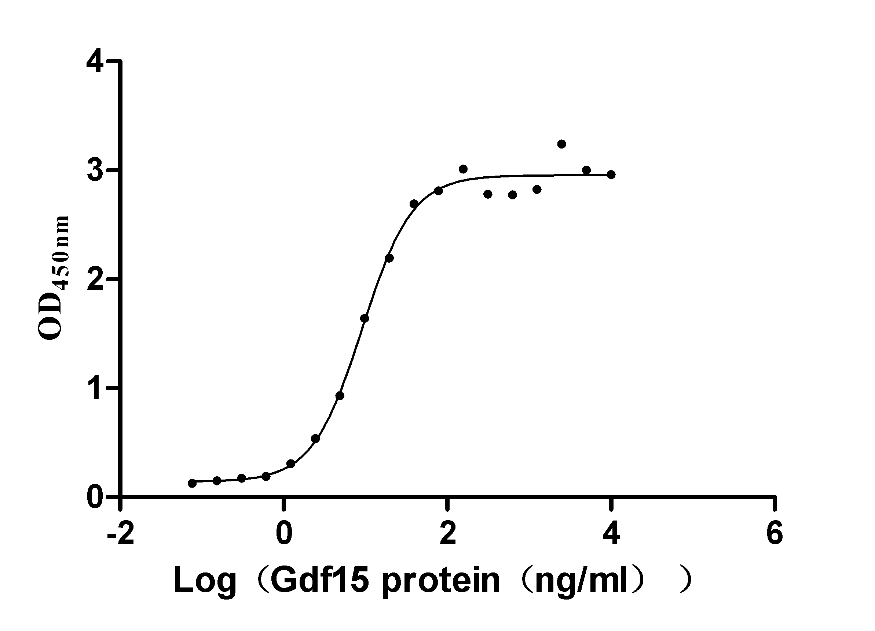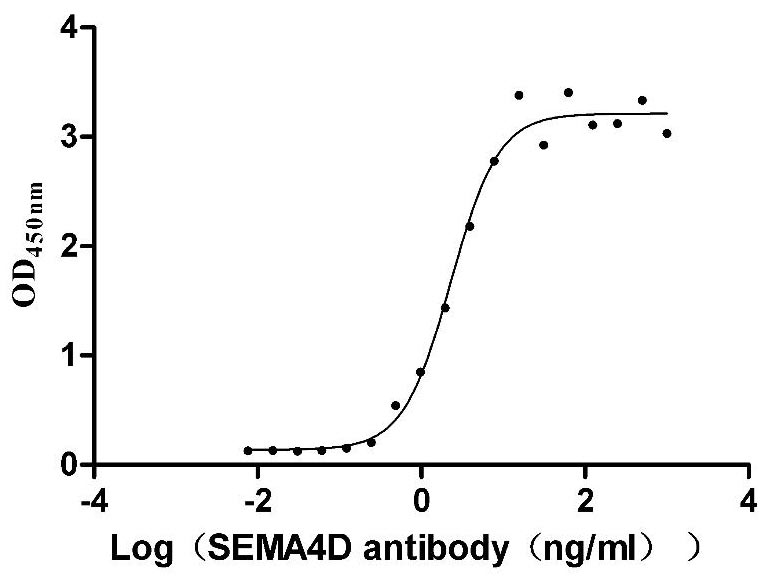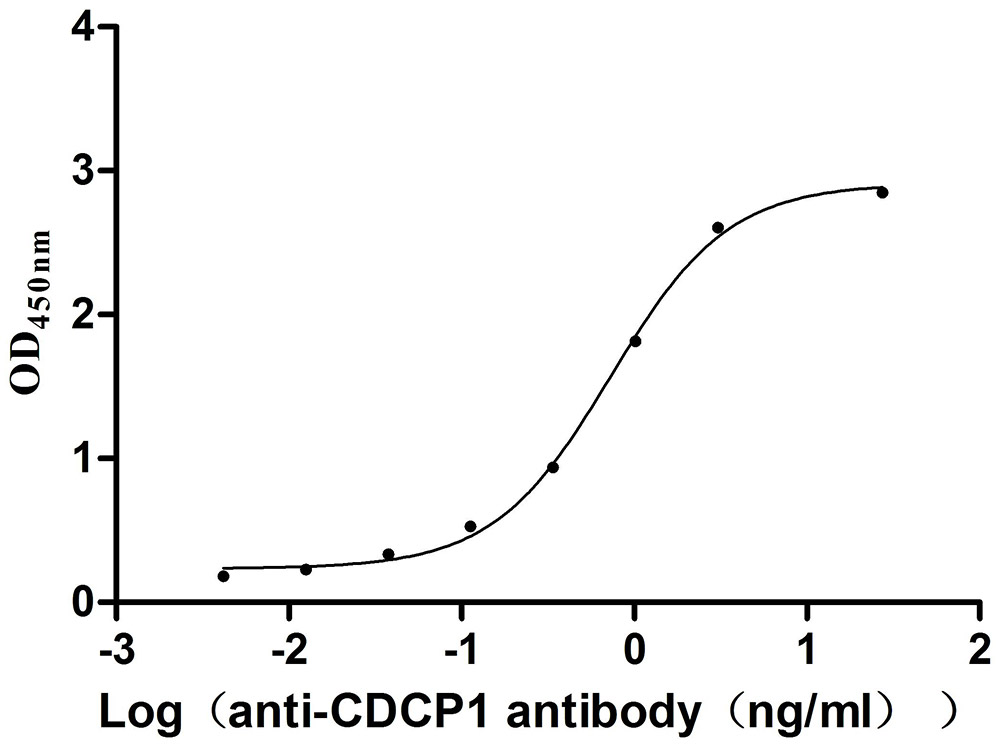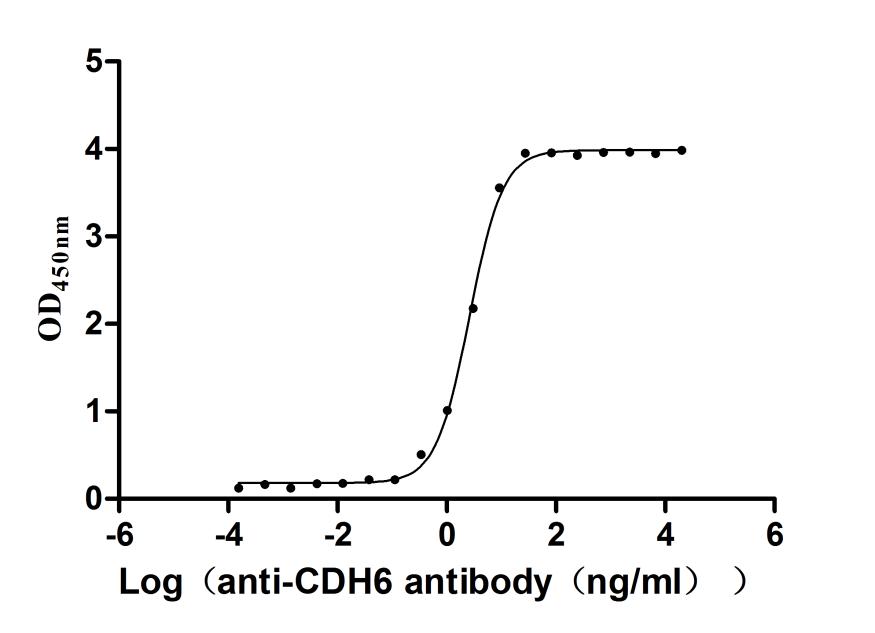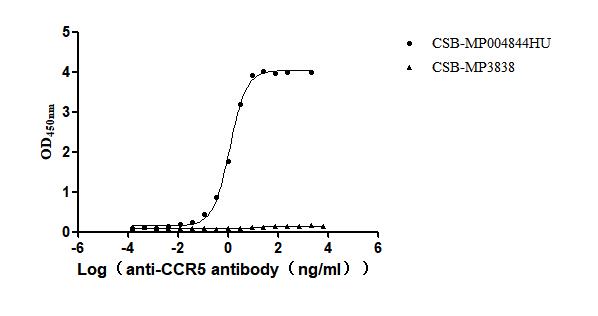Recombinant Mouse Mucolipin-1 (Mcoln1), partial
-
中文名稱:小鼠Mcoln1重組蛋白
-
貨號:CSB-EP859533MO1-B
-
說明書:
-
規(guī)格:
-
來源:E.coli
-
共軛:Avi-tag Biotinylated
E. coli biotin ligase (BirA) is highly specific in covalently attaching biotin to the 15 amino acid AviTag peptide. This recombinant protein was biotinylated in vivo by AviTag-BirA technology, which method is BriA catalyzes amide linkage between the biotin and the specific lysine of the AviTag.
-
其他:
產(chǎn)品詳情
-
純度:>85% (SDS-PAGE)
-
基因名:
-
Uniprot No.:
-
別名:Mcoln1; Trpml1; Mucolipin-1; Mucolipidin; Transient receptor potential-mucolipin 1; TRPML1
-
種屬:Mus musculus (Mouse)
-
蛋白長度:Partial
-
蛋白標簽:Tag?type?will?be?determined?during?the?manufacturing?process.
The tag type will be determined during production process. If you have specified tag type, please tell us and we will develop the specified tag preferentially. -
產(chǎn)品提供形式:Lyophilized powder Warning: in_array() expects parameter 2 to be array, null given in /www/web/cusabio_cn/public_html/caches/caches_template/default/content/show_product_protein.php on line 668
Note: We will preferentially ship the format that we have in stock, however, if you have any special requirement for the format, please remark your requirement when placing the order, we will prepare according to your demand. -
復(fù)溶:We recommend that this vial be briefly centrifuged prior to opening to bring the contents to the bottom. Please reconstitute protein in deionized sterile water to a concentration of 0.1-1.0 mg/mL.We recommend to add 5-50% of glycerol (final concentration) and aliquot for long-term storage at -20℃/-80℃. Our default final concentration of glycerol is 50%. Customers could use it as reference.
-
儲存條件:Store at -20°C/-80°C upon receipt, aliquoting is necessary for mutiple use. Avoid repeated freeze-thaw cycles.
-
保質(zhì)期:The shelf life is related to many factors, storage state, buffer ingredients, storage temperature and the stability of the protein itself.
Generally, the shelf life of liquid form is 6 months at -20°C/-80°C. The shelf life of lyophilized form is 12 months at -20°C/-80°C. -
貨期:Delivery time may differ from different purchasing way or location, please kindly consult your local distributors for specific delivery time.Note: All of our proteins are default shipped with normal blue ice packs, if you request to ship with dry ice, please communicate with us in advance and extra fees will be charged.
-
注意事項:Repeated freezing and thawing is not recommended. Store working aliquots at 4°C for up to one week.
-
Datasheet :Please contact us to get it.
相關(guān)產(chǎn)品
靶點詳情
-
功能:Nonselective cation channel probably playing a role in the regulation of membrane trafficking events and of metal homeostasis. Proposed to play a major role in Ca(2+) release from late endosome and lysosome vesicles to the cytoplasm, which is important for many lysosome-dependent cellular events, including the fusion and trafficking of these organelles, exocytosis and autophagy. Required for efficient uptake of large particles in macrophages in which Ca(2+) release from the lysosomes triggers lysosomal exocytosis. May also play a role in phagosome-lysosome fusion. Involved in lactosylceramide trafficking indicative for a role in the regulation of late endocytic membrane fusion/fission events. By mediating lysosomal Ca(2+) release is involved in regulation of mTORC1 signaling and in mTOR/TFEB-dependent lysosomal adaptation to environmental cues such as nutrient levels. Seems to act as lysosomal active oxygen species (ROS) sensor involved in ROS-induced TFEB activation and autophagy. Functions as a Fe(2+) permeable channel in late endosomes and lysosomes. Proposed to play a role in zinc homeostasis probably implicating its association with TMEM163. In adaptive immunity, TRPML2 and TRPML1 may play redundant roles in the function of the specialized lysosomes of B cells.; May contribute to cellular lipase activity within the late endosomal pathway or at the cell surface which may be involved in processes of membrane reshaping and vesiculation, especially the growth of tubular structures. However, it is not known, whether it conveys the enzymatic activity directly, or merely facilitates the activity of an associated phospholipase.
-
基因功能參考文獻:
- stimulation of TRPML1 elevates cytoplasmic calcium levels in retinal pigmented epithelial cells, but this response is reduced by lysosomal accumulation. PMID: 29030399
- single-particle electron cryo-microscopy structure of the mouse TRPML1 channel embedded in nanodiscs; combined with mutagenesis analysis, the TRPML1 structure reveals that phosphatidylinositol-3,5-bisphosphate (PtdIns(3,5)P2) binds to the N terminus of the channel-distal from the pore-and the helix-turn-helix extension between segments S2 and S3 probably couples ligand binding to pore opening PMID: 29019981
- TRPML1 overexpression or treatment with the mTOR activator propranolol also attenuated the amyloid beta-protein (1-42)-inhibited mTOR/S6K signalling pathway and theamyloid beta-protein(1-42)-induced autophagic lysosome reformation -related protein expression levels. PMID: 29131026
- It has been proposed that TRPML1 is regulated by pH, Ca2+, and phosphoinositides in a combined manner in order to accommodate the dynamic endocytosis process. PMID: 28936784
- Deletion of TRPML1 increases secretory organelle size by fusion with lysosomes. Enhanced exocytosis that was rescued by re-expression of TRPML1 in neurons. PMID: 26682800
- Silencing of TRPML1 hindered phagosome fusion with lysosomes. PMID: 26010303
- lack of both mucolipins 1 and 3 causes an accelerated mucolipidosis IV-type of vacuolation in enterocytes PMID: 25521295
- In the title. PMID: 25491304
- These results demonstrate that the PtdIns(3,5)P2-Mcoln1 axis has an important role in ssRNA transportation into lysosomes in DCs. PMID: 25239130
- ML1-null mice develop a primary, early-onset muscular dystrophy independent of neural degeneration. Dystrophin-glycoprotein complex and known membrane repair proteins are expressed normally, but membrane resealing was defective in ML1-null muscle fibers. PMID: 25216637
- Data identified proteins as candidate TRPML1 interactors, and some false-positive interactors. PMID: 23418601
- Transfection of CAMs with plasmids containing a full-length TRP-ML1 gene enhanced FasL-induced two-phase Ca2+ release. PMID: 23283937
- Loss of Trpml1 causes reduced levels and mislocalization of the gastric proton pump and alters the secretory canaliculi, causing hypochlorhydria and hypergastrinemia. PMID: 21111738
- This study describes, for the first time, a defect in macroautophagy in mucolipin-1-deficient mouse neurons. PMID: 20600908
- the loss of TRPML1 function results in intracellular chelatable zinc dyshomeostasis. PMID: 20864526
- TRPML1 is expressed in the mouse inner ear. PMID: 20095091
- Mucolipin-1 functions in the efficient exit of molecules, destined for various cellular organelles, from lysosomal compartments PMID: 18154673
- TRPML1 functions as a Fe(2+) permeable channel in late endosomes and lysosomes PMID: 18794901
- This neuropathological characterization of the Mcoln1(-/-) mouse provides an important step in understanding how mucolipin 1 loss of function affects the CNS and contributes to mucolipidosis type IV disease. PMID: 19151629
- TRPML1 appears to play a novel role in the tissue-specific transcriptional regulation of TRPML2 PMID: 19763610
顯示更多
收起更多
-
亞細胞定位:Late endosome membrane; Multi-pass membrane protein. Lysosome membrane; Multi-pass membrane protein. Cytoplasmic vesicle membrane; Multi-pass membrane protein. Cell projection, phagocytic cup. Cytoplasmic vesicle, phagosome membrane; Multi-pass membrane protein. Cell membrane; Multi-pass membrane protein.
-
蛋白家族:Transient receptor (TC 1.A.4) family, Polycystin subfamily, MCOLN1 sub-subfamily
-
組織特異性:Widely expressed, with the highest expression in brain, liver and kidney.
-
數(shù)據(jù)庫鏈接:
Most popular with customers
-
Recombinant Severe acute respiratory syndrome coronavirus 2 Spike glycoprotein (S), partial (Active)
Express system: Mammalian cell
Species: Severe acute respiratory syndrome coronavirus 2 (2019-nCoV) (SARS-CoV-2)
-
Recombinant Human Tumor necrosis factor ligand superfamily member 18 (TNFSF18), partial (Active)
Express system: Mammalian cell
Species: Homo sapiens (Human)
-
Recombinant Mouse GDNF family receptor alpha-like (Gfral), partial (Active)
Express system: Mammalian cell
Species: Mus musculus (Mouse)
-
Recombinant Macaca mulatta Semaphorin-4D isoform 1 (SEMA4D), partial (Active)
Express system: Mammalian cell
Species: Macaca mulatta (Rhesus macaque)
-
Recombinant Mouse CUB domain-containing protein 1 (Cdcp1), partial (Active)
Express system: Mammalian cell
Species: Mus musculus (Mouse)
-
Recombinant Human Cadherin-6 (CDH6), partial (Active)
Express system: Mammalian cell
Species: Homo sapiens (Human)
-
Recombinant Human C-C chemokine receptor type 5 (CCR5)-VLPs (Active)
Express system: Mammalian cell
Species: Homo sapiens (Human)



